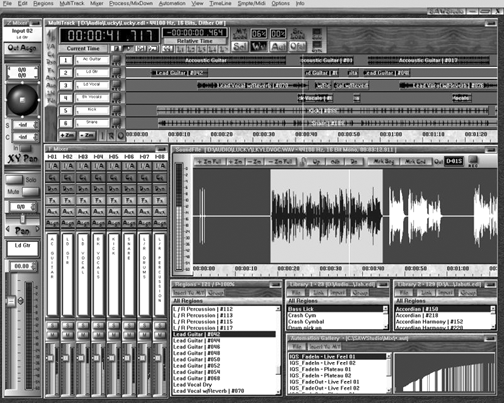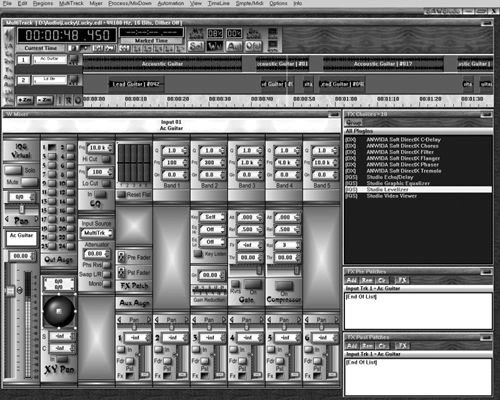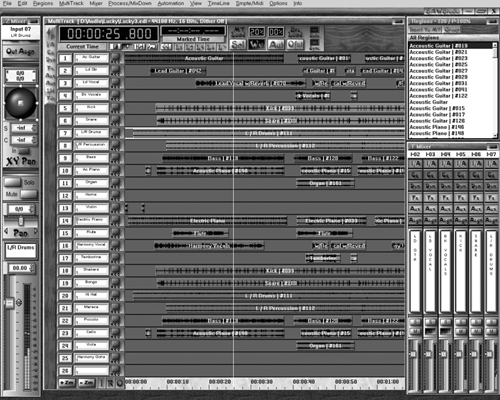by Steve Cunningham
Bob Lentini’s Software Audio Workshop, or SAW, has been a player in the PC multitrack audio field since the early 1990’s. Its loyal users rave about its speed and capabilities, thanks to an audio engine constructed entirely in assembly language to squeeze the maximum performance from a Wintel CPU. But SAW was expensive and its learning curve was steep, and during the downturn of 2001 Lentini was forced to shut down his company, IQS.
While that company may be no more, Bob and his products are very much alive, thank you, under the flag of RML Labs. RML has released a new version of SAW, dubbed SAWStudioBasic, that features the same fast assembly-language engine as its more expensive siblings, but at a radio-friendly price of $300.
SAWStudioBasic (hereafter referred to as simply SAW) is a 24-track recorder/editor, with a full mixer and effects. The 24 input tracks can be mono or stereo, and SAW supports multiple sound cards for up to 16 separate outputs. Sample rates up to 192kHz are supported, as are 16-, 20-, and 24-bit resolutions. Low-latency ASIO sound drivers are well supported, although the program will also run quite happily using standard Windows audio drivers and sound cards. You can use any of your DX or VST plug-in effects in SAW, as well as the company’s proprietary IQS format effects. There are also quite a few third-party plugs out there that are designed especially for SAW.
The program’s requirements are not stiff — a Pentium II-450 or higher machine running Windows NT, Windows 2000, or Windows XP will do. Of course, the faster the CPU, the more tracks and effects you’ll get, but SAW’s performance is snappy even on the 1GHz P3 machine I used to evaluate it. You’ll need a minimum of 256 MB of RAM (384 MB or more is recommended), and a monitor that will display at 1024 x 768 or higher resolution and 65,000 colors. Installation is simple, since the program is sold, delivered, and authorized through www.sawstudio.com. Once you’ve purchased the software, RML emails you a link and a pass code that allows you to download the program, and no further authorization is necessary.

FIRE IT UP
When you first fire up SAW you’ll want to visit the Options menu to assign your sound card and drivers in the Audio Device Setup menu. You’ll also want to use the File Path Setup option to tell SAW where to record audio and find its various files.
Once that’s set you can spend some time exploring the interface. Unlike other audio editors, SAW’s interface doesn’t always follow the tape-recorder paradigm that most editors adhere to. For example, the transport controls don’t include a fast-forward or rewind button, since when you think about it there’s no pressing need for either. We’re not shuttling through tape, and we can click on a location to go there instantly, so who needs ‘em? As a result, SAW’s interface can be daunting at first, but here are some descriptions to help you get comfortable.
There are only about four windows that you’ll use regularly and will need to understand. The largest and most obvious of these is the MultiTrack window, which displays your tracks. The upper left is home to the main counter and the transport buttons. Next to these is the Marked Time indicator that shows the length of a selection, and four locate buttons. To the right of those are four mode buttons for Selection, Waveform, Automation, and Offset, with the latter two being dedicated to mix automation functions. Also here are two indicators that show you the CPU load and the load on disk and RAM access. Below all these are your tracks, which show as waveforms if the Wv button is lit, and as blocks if it’s not.
There’s a little strip on the leftmost edge of the MultiTrack window that is connected to the E Mixer window, which is the strip you’ll generally see on the far left of the screen. See, the E Mixer strip is a complete channel strip that shows all the settings for the currently selected track (known in SAW parlance as the Hot Channel). But the strip is far too long to display on the screen in its complete form, so you can view sections of the E Mixer strip by clicking on the little strip in the MultiTrack window. For example, to see the equalization settings you’d click, the Eq label on the strip, while clicking the Fdr label shows you the fader, pan, mute and solo portion of the strip. You can also right-click on the E Mixer strip to scroll up and down through all the sections, but it’s much quicker to click the labels.
The third important window is the F Mixer, which is simply a smaller, simplified view of the entire mixer. Clicking here on any channel makes it Hot, and it’s then displayed in full in the E Mixer window. Finally, the Library window is a browser that will list all the valid wave files it finds in any directory you choose. Right-clicking on any of these files will cause it to play and display as a waveform in the SoundFile window. This window is brought forward when you double-click on a region in the MultiTrack window, or when you right-click on a file in the Region List or Library window. It will show the file in high detail, but you cannot edit from within it — all editing occurs in the MultiTrack window.

QUICK EDIT TIPS
Here’s a quick tip — SAW allows for up to 12 window sets, each of which can be recalled by hitting one of the twelve F-keys on your keyboard. You’ll want to try all of them in turn, and you can learn a lot about the interface and how flexible it is by simply reviewing the included window sets. For example, the F1 key brings up a set that’s good for general recording and playback, showing the first 10 tracks and 18 mixer channels, along with the E Mixer strip and a list of current Regions used in the project. F4 brings up a set that's much the same, except that track one in the MultiTrack window is zoomed in vertically, which makes it perfect for editing.
Editing in SAW is a different experience. Not worse, not better, but decidedly different. And it’s here that you’ll want to have the PDF manual open in the background, because the best way to get fast on SAW is to get fast with keyboard commands. For example, let’s say your VO talent flubbed a line, and started reading from the top while you recorded the entire performance. The fastest way to remove the bad line in SAW is to locate your cursor at the beginning of the new line, press K to split the recording at that point, then hold shift and left-click the new line and drag it over the old line. When you begin to learn some of these various keyboard and mouse commands, this entire process becomes extremely quick.
Other click-modifier commands let you precisely align regions between tracks, snap to previous regions, cut and leave space, or cut and butt splice. It’s all very fast once you know the commands.
Interestingly, scrubbing is not supported in any version of SAW. In other words, you can’t drag the cursor across a sound file and hear it play in slow speed. However, by selecting a region and pressing control-spacebar you can play just that selected region to find a specific edit point. It’s come to the point that I rely on my eyes as much as my ears to find and eliminate audio problems, so I did not miss the lack of reel-rocking, although some certainly will.
The screen-redraws in SAW are blindingly fast, I’m sure due to the assembly-language nature of the program. Scrolling, editing, slipping and sliding tracks is very fast, and the screen never seems to glitch. Just switching between screen layouts will make you dizzy if you press those F-keys fast enough.

THE MIXER
The SAW mixer is a full-blown digital mixing console, allowing control over 24 mono or stereo inputs and up to 16 separate outputs. Each channel comes complete with five bands of fully-parametric Q, a low and high cut filter, a gate and a compressor, six aux sends, both pre- and post-fader inserts, and even a surround panner. Every function on the mixer is, of course, totally automated. Clicking on the Automation button in the upper right corner of the MultiTrack window gets you started.
The mixer is by far the quickest way to deal with some problems, including some that you’d fix in the editor on other workstations. For example, to remove a breath or mouth noise in Pro Tools I normally select the noise in the waveform view, switch to the volume automation graph view for that track, then use the Trimmer tool to pull the volume down and switch back to the waveform view for further editing. In SAW it’s actually a bit faster, as I just select the noise in the waveform view, hit the “a” key to fire up automation, pull the fader down and hit “a” again to turn automation off.
Now it’s true that I could perform similar steps in Pro Tools and achieve the same results, but it just seems pokier. Maybe it’s the instantaneous screen redraw that makes it all seem that much faster, I dunno. But it’s all very, very quick, particularly when you get familiar with keystrokes.
Fades can be accomplished in a similar manner... in fact simply selecting a region and pressing the “f” key creates a fade-out using automation. Pressing “shift-f” creates a fade-in, and both of these processes respect any existing fader levels, allowing you to create a smooth fade between two abrupt level changes.

EFFECTS, BUSSES, AND LIBRARY
SAW comes with but two effects plug-ins of its own — a nice little six-band graphic equalizer and a stereo delay. But it can use any DX or VST format plug-in effect, and in fact the program automatically found all of my DX effects from my installed copy of Acid Pro 4. As mentioned, each channel has six aux sends, and of course there are six aux returns in the console to go with them. Each send has level and pan, and switches to make it either pre- or post-fader and pre- or post-insert.
I borrowed an RME sound card with eight AES inputs and outputs for a portion of the evaluation period, and was pleasantly surprised at how well SAW worked with that bit of hardware. The auxes made it a simple matter to send a track out to an external reverb or compressor and bring it back in again, and the amount of latency involved in doing so was quite low. That is to say, I perceived no delay between the dry track and the effected track coming back via the aux return, and that’s a condition that afflicts several other editors I use. Suffice it to say that there are plenty of ways to get your sound in and out of SAW, and with good, low-latency hardware it’ll do it quickly.
I’d be remiss if I didn’t mention the Library window and import functions in a bit more detail, as it’s one of the more clever implementations I’ve run across. The Library will create a list of all WAV files in any folder you choose, and allows you to audition them by right-clicking. Once you’ve found a clip you like, you can alt-left-click it to grab it, then drag it into a track in the MultiTrack window. Quick and painless, and ideal for shuffling through a CD of sound effects as you’re building a spot.
DOCUMENTATION
SAW has a healthy learning curve, and you’ll want to take advantage of all the instructional and tutorial materials provided. For starters, check out the 14-minute Windows Media video available on www.sawstudio.com. Bob Lentini himself will take you through a highly-caffinated demo of the product and the process. The tutorial is an online affair, with web pages with pictures and text that link to online audio narration files that describe the pictures. It’s quite comprehensive, and going through the tutorial in its entirety took me several two-hour sessions. But it’s pleasant and worthwhile.
Current and past users of the various incarnations of SAW maintain bulletin boards on the web, which are also useful founts of information and tips. One of the best is SAWStudioUser, which can be found at www.sawstudiouser.net. Several developers continue to provide third-party plug-ins for SAW in its native IQS format. A Google search on “SAW” and “software” will turn up quite a few.
Finally the PDF manual weighs in at a hefty 266 pages, with the key commands alone taking up twenty-six of those pages. Print the key commands out, and keep the rest of the manual open on your computer as you begin to work. Until you get into the Zen of SAW, you’ll need the manual.
A SAW IS NOT A HAMMER
I seem to remember having used a version of SAW many moons ago, probably back in the day of Intel 386 processors. I recall it as fast even then, with an interface that was difficult and not pleasant to look at for extended periods. It was also pricey in those days, and there are still high-priced versions available today. SAWStudio weighs in with 72 tracks, 24 stereo outputs, multiple Libraries, and video capabilities at a price of $2,500, and SAWStudioLite gives you half those specs for $1,200. Not exactly radio-friendly.
SAWStudioBasic is still an extremely fast editor, once you’ve gotten over the initial learning hump. And in its native color scheme it still won’t win any design awards. However, RML Labs has a half-dozen skins on its website that are available for free downloading, and they’re a substantial improvement over the native look. Just go get ‘em, and you’ll be happier. And at a price of $300, it’s faster and more capable than several others. The price is right.
Having said all that, and having scaled the initial hump myself, I’m finding it hard to quit working with this program. It continues to unfold as I use it, and I find more ways to work more quickly. The program has not hiccupped on me once during these past several weeks, and I’m finding myself doing edits on it that would be tedious in Pro Tools (my main rig).
I’ve really only touched on the high points in the program here. For example, SAW is capable of being controlled by several MIDI control surfaces, and comes with built-in sample rate conversion software. It also bounces multitrack projects to stereo much faster than real time, something that Pro Tools in unable to do (much to my dismay).
SAWStudioBasic is an impressive software package. Fire it up with an open mind, and you’ll be surprised. Steve sez check it out. And Bob, glad to see you back.
SAWStudioBasic is available direct as a download at a price of $300. For more information worldwide, visit www.sawstudio.com.
♦

